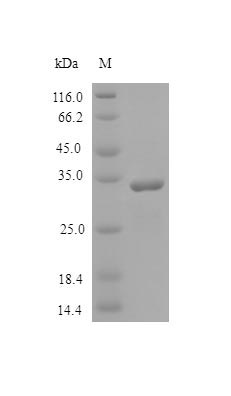Recombinant Human SPARC protein is produced in E. coli and spans the 18-303 amino acid region. This tag-free protein achieves purity levels greater than 98% as confirmed by SDS-PAGE. The protein remains fully biologically active, showing an ED50 of less than 3.0 µg/mL when inhibiting growth of Mv1Lu mink lung epithelial cells—this suggests a specific activity of over 333 IU/mg. Endotoxin levels stay below 1.0 EU/µg, as measured by the LAL method.
SPARC, or Secreted Protein Acidic and Rich in Cysteine, is a matricellular protein that participates in several biological processes. These include cell-matrix interactions and tissue remodeling. It appears to play a critical role in modulating cell adhesion, proliferation, and migration. This makes SPARC an important subject for studies examining extracellular matrix dynamics and cellular signaling pathways. Its significance in these areas likely makes it a valuable research tool for cell biology and tissue engineering work.
Potential Applications
Note: The applications listed below are based on what we know about this protein's biological functions, published research, and experience from experts in the field. However, we haven't fully tested all of these applications ourselves yet. We'd recommend running some preliminary tests first to make sure they work for your specific research goals.
1. Cell Growth Inhibition Assays for Cancer Research
This recombinant SPARC protein is confirmed to be biologically active (ED₅₀ < 3.0 μg/mL in Mv1Lu cells) and suitable for growth inhibition studies. However, the relatively high ED₅₀ and low specific activity (>333 IU/mg) indicate moderate potency compared to many cytokines. Researchers should validate activity in human cancer cell lines to confirm cross-species reactivity, as the validation data is from mink lung epithelial cells. The high purity (>98%) supports reliable results, but effective concentrations may be significantly higher than typical cytokine doses.
2. Extracellular Matrix Interaction Studies
The protein is appropriate for ECM interaction studies, but the partial sequence (18-303aa) may lack functional domains present in full-length SPARC. Binding assays should validate that interactions with collagen, fibronectin, and other matrix proteins match those of full-length SPARC. The tag-free design supports authentic interactions, but the partial nature may affect binding avidity or specificity for some ECM components.
3. Anti-SPARC Antibody Development and Validation
This partial SPARC serves as a limited antigen for antibody development. Antibodies will only recognize epitopes within the 18-303aa region and may miss important conformational epitopes requiring the full-length protein. Comprehensive validation should include testing against full-length SPARC to ensure recognition of all functional domains. The moderate bioactivity may challenge functional neutralization assays.
4. Protein-Protein Interaction Screening
The biologically active SPARC fragment can be used for interaction screening, but the partial sequence may miss important binding partners that interact with the missing N- and C-terminal regions. Identified interactions should be validated with full-length SPARC to confirm biological relevance. The moderate potency may reflect structural alterations affecting some interaction interfaces.
5. Wound Healing and Tissue Repair Model Studies
The protein is suitable for wound healing assays, but the high working concentrations (μg/mL range) may cause non-specific effects in sensitive migration assays. Researchers should include appropriate controls and validate that effects match those of full-length SPARC. The partial sequence may not fully recapitulate native SPARC's complex role in tissue remodeling, which involves multiple functional domains.
Final Recommendation & Action Plan
This recombinant human SPARC partial protein (18-303aa) has confirmed bioactivity but exhibits moderate potency, requiring careful experimental design and validation. For cell-based assays, use concentrations in the 1-10 μg/mL range based on the ED₅₀, but include full-length SPARC controls to confirm physiological relevance. The partial nature necessitates validation of key findings with full-length protein, particularly for ECM interactions and functional studies where missing domains may be important. For antibody development, this fragment is suitable for generating domain-specific reagents, but comprehensive validation requires full-length SPARC. The E. coli expression produces non-glycosylated protein, which is acceptable as SPARC has minimal glycosylation, but critical conclusions should be verified with mammalian-expressed protein. Always include dose-response curves and appropriate controls accounting for the moderate potency, and consider that different cell types may exhibit varying sensitivity to SPARC-mediated effects.






